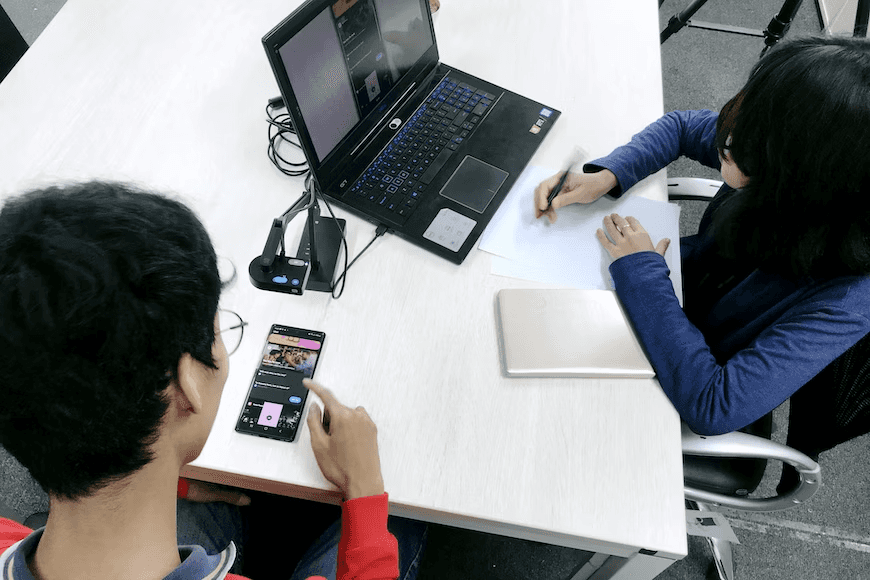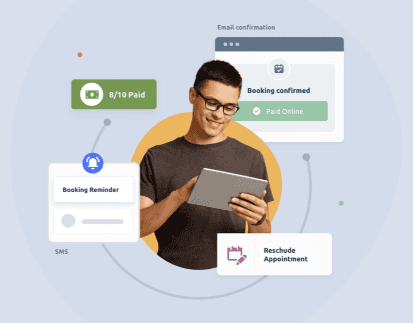

Priyanka Damwani
Priyanka leads the Marketing team at OnlyDomains, where she is responsible for the website, communications and marketing strategy.
You can make pretty much everything better. In an imperfect world, improvements are just waiting to be made to most things. OK, there are some flawless diamonds knocking around, and the Goldberg Variations would probably suffer from any well-intentioned tweaking, but the overwhelming majority of things in this universe of ours can always be made better.
Just so with the creative process. It consists of a series of steps, most if not all of which can always benefit from an enhancement effort. We’ll take a look at each of these steps and see what might be done to improve their functionality.

What are the Design Process Steps?
Most designers, whether they be graphic designers or systems designers, and wherever in the world they happen to be, tend to follow certain prescribed steps to completion. It helps the designer if everyone follows these steps, as it then formalizes the work and keeps it focused.
Design can have a nasty tendency to go off the rails if moderation isn’t applied. Egos and flights of fancy can take over and before you know where you are, you have a design catastrophe that was meant to please everyone but leaves nobody happy.
Using pre-planned steps gives more of a template approach, which can help to keep client ambitions and fantasies in check, as well as keep the overall process organized and predictable.
Below are some steps commonly applied to the creative design approach:
- Problem identification
- Problem research
- Possible solution generation
- Solution evaluation
- Prototype creation
- Prototype testing
- Readying for release
Let’s look at each in more detail.
1. Problem Identification

When you’re looking at the initial problem, you need to be attentive to various factors, or you may address the wrong need. Start by asking yourself what the problem is and who has it.
Then, set out who is likely to benefit from an effective solution and who might suffer. Outside of a lab, nothing is achieved in isolation, so it’s always important when considering how to improve the design process to think about the whole organization.
Everything you introduce to a system will have unintended effects, so it’s best you start thinking about those straight away and discuss them with the client. This can be anything from the language barriers that occur from creating a website with a .hk domain to having to consider whether certain aspects of the project might need to be outsourced.
Once you have an idea of the scale of the problem and the size of the solution needed, you’ll start to get an idea of the overall dimensions of the entire project. Again, it’s important to discuss this with the client, as duration and cost will be affected.
At this stage, it’s important to become aware of any constraints. If the project has to be completed within three months, it’s crucial to know this here and now.
With all this information clearly set out, the designer should be in a position to set out some initial thoughts about the shape of the design project. In order for this step to be as effective as possible, there has to be clear communication with the client here. The client has to be honest about their goals, and the designer has to be honest about what’s possible.
when identifying the problem and planning the design project, it can be a good idea to search for someone who caters to your specific needs. For example, if you work for a charity, you may want to search for someone who specializes in website creation for non-profits. They will be more likely to cater to your needs or come up with innovative ideas related specifically to your aims.
2. Problem Research
This step is often about looking at the market and seeing what’s happening out there. A designer that seeks to plow their own furrow with no reference to the outside world will do some very independent work but may also miss some important market trend elements.
By taking on board what competitors have done, a designer can decide to build on the work of others or reject it and create something new.
Furthermore, utilizing a content creation platform can provide designers with access to a vast array of resources and inspiration to enhance their research process. Whether it's exploring design trends, accessing design assets, or gathering insights from industry experts, a content creation platform can be a valuable tool in optimizing the design process.
What’s certain is that a designer with an eye on the market will spot where competitors have neglected to meet client needs and can zero in on this, giving their product unique value.
Sometimes, it’s tempting to skip over this stage in order to get busy with the actual designing part, but it can’t be emphasized enough that research pays off. So, when it comes to seeking to optimize the design process, research should never be neglected.
3. Possible Solution Generation

OK, here’s where the exciting stuff happens. A designer thrives on new ideas, and new design ideas are what it’s all about at this step. Creativity is a funny thing. It can come in torrents and then go dry as the Gobi. So, it needs optimization. Here’s how.
a) Go team!
The popular conception of a maverick design genius, churning out their own vision and unencumbered by the pedestrian output and constricted horizons of others, is, in reality, a rare beast.
The most successful design ideas come from teams. These collectives need to have a clear understanding of the problem (hence steps one and two) and a solid grasp of what’s expected of them. The team doesn’t have to be together in the same office - there are great techniques for remote teams that can give rise to effective collaboration across continents and time zones.
All being well, the team will then go to work, with cross-fertilization and synergies producing creative ideas and design concepts that an individual would struggle to generate. Get the ideas on paper, on-screen, or wherever you like to see your ideas take shape.
b) Organize
There can be a problem with all this wild creativity. How do you organize the output? One technique is called, somewhat prosaically, the Four Categories method. This involves grouping the ideas into four sections, labeled as follows:
- Most rational - these are the ideas that follow the brief and are easiest to implement
- Most delightful - will delight most customers
- Darling - the favorite idea of each group member
- Long shot - a bit of an unlikely one that, if it goes right, may have huge benefits
Each group member then chooses their favorite (or maybe favorite two) from each category. These are the ideas that then get fully worked out in the next step.
4. Solution Evaluation

Here’s where each idea on the shortlist gets pulled apart to see how it fits the brief. It’s important not to let just one person do this. Some may argue that it takes less time to give it to an individual to complete, but important aspects can be overlooked if it’s just down to a single employee.
If the workforce is dispersed due to remote working, that shouldn’t stop effective collaboration. Using tech such as a Kanban board can connect people around the world, so the ideas under scrutiny will then be given a much more exhaustive analysis. This will help to optimize the design process.
5. Prototype Creation
This is where the most well-regarded idea gets knocked into some kind of shape. It’s important not to confuse this step with final product creation. It doesn’t have to have all the finished features, and it doesn’t have to look utterly amazing. It just has to get across the main ideas behind its use, and it needs to do it quickly.
To visually communicate the design concept effectively, designers can utilize various tools, such as an infographic maker, to create quick visual representations that convey the main ideas behind the prototype and facilitate better understanding and feedback.
Design processes can very easily meander and get sluggish if too much time is wasted here. Optimization depends on keeping things tight and timely.
6. Prototype Testing

This is where you need to assess user experience and customer journey in order to see if the prototype is doing what’s needed. Obviously, allowances have to be made for the roughness of the appearance of the product, but the underlying process has to deliver what’s required.
A great way to optimize this step is to involve external parties. If your testing panel consists of people involved in the design, you may find that the testing uses a very low bar.
So, let’s say that the prototype is for a business phone app. Get business people to use it as they might during an everyday work situation, then report back on how it compares with other phone apps they’ve used. Would they choose the new product over what they have already? If not, why not?
External testers won’t have any allegiance, so they will be more honest, and when it comes to preparing a product, fresh eyes are invaluable.
7. Readying for Release
You’ll need to absorb and incorporate any pertinent test findings into the finished product. This is a fairly straightforward step, but two factors have to be borne in mind if you’re looking to optimize it.
Firstly, it’s important to administer any improvements in a speedy fashion so as to stick to the release schedule, so make sure you dedicate enough resources to allow this. Secondly, keep the client informed of how things are shaping up. This will stop any nasty surprises when it hits the market.
Thereafter, it's a case of keeping the client feedback channel open. This way, future creative projects can benefit from the experiences of everyone involved in previous ones.
Seven Steps to Design Heaven
By sticking to these steps and incorporating the improvements we advocate, it’s possible to improve the creative design process. Key among our recommendations is communication. It’s where the best ideas come from, and it’s where snags can best be mended. So, get those design heads together for the best effect.
However - and here’s the twist! - it might be wrong to say that you can, in reality, optimize the creative design process.
To optimize implies that you’ve reached the very best iteration of a thing. With the ever-greater reach of new technology, such as the potential for workflow improvements that innovations such as ChatGPT WordPress integration can deliver, it’s not sensible to think that we might, at present, be able to reach the apex of what’s eventually possible.
In any case, with design, the objective optimal is unlikely ever to be achieved. You can always go one better. That’s what’s so great about design and what keeps us striving for the very best.

About the author
Priyanka Damwani
Priyanka leads the Marketing team at OnlyDomains, where she is responsible for the website, communications, and marketing strategy.
After majoring in advertising, she joined the domain name industry in 2009 and has worked on channel and customer marketing throughout her career. She’s worked across a variety of verticals, like branding & visual design, email marketing, optimizing conversions, content creation, and lead management.
Priyanka brings over 13 years of experience in the tech and domain name industry and enjoys the mix of creative and data-driven challenges that come her way. Here’s her LinkedIn.
Related articles


